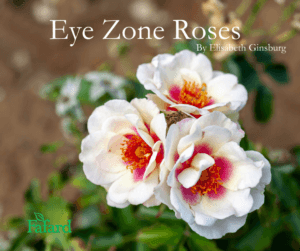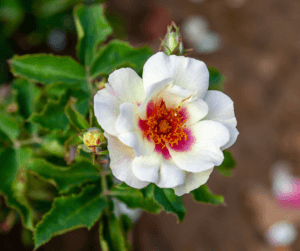
For garden lovers, the landscape is full of “eyes”–bi-colored flowers with petals that include a central “eye” or ring that contrasts with the main flower color. Members of the mallow family, like hollyhocks and rose-of-Sharon have them, but garden roses usually do not. Now plant breeders have changed all that and the eyes have it among rose fanciers.
The genes for the rose “eye zone” trait came from a plant known—depending on the sources– botanically as Rosa persica, Hulthemia persica or Hulthemia berberifolia. Whatever you call it, the important thing to remember is that hulthemia, a plant native to eastern Iran and surrounding areas, is a thorny, scraggly shrub that sports bright yellow flowers with unusual red centers. It blooms in summer and is well adapted to its native hot, dry climate. It is clearly related to the genus Rosa, home of true roses, but lacks some rose characteristics.

photo by Proven Winners® Ringo All-Star™
Hulthemia might still be an obscure plant, if not for those “eyes”, which have entranced breeders for years, inspiring them to cross hulthemia with garden rose varieties to produced offspring with eyes. Some of the first matchmaking attempts were made by Englishman Jack Harkness, who bred roses for his family’s firm from 1964 until his death in 1994. Obtaining hulthemia seeds, Harkness worked to breed reblooming rose varieties that had the characteristic hulthemia appearance. Harkness eventually introduced four hulthemia/rose varieties: ‘Euphrates,’ ‘Tigris,’ ‘Nigel Hawthorne’ and ‘Xerxes.’ Unfortunately, none were reliable rebloomers and only ‘Tigris’ produced viable seed for future crosses. The matchmaking efforts continued, with further crosses made by Harkness and other breeders in England and America, including Ralph Moore, a Californian best known for his miniature roses.

Photo by Elisabeth Ginsburg
In a 2007 article, an American rose breeder named James A. Sproul of Bakersfield, California, wrote about the hulthemia breeding process. According to Sproul, the genes that produce the characteristic “eyes” seem to be linked to genes for non-repeat blooming. The majority of modern rose buyers look for roses that rebloom reliably, which made hulthemia breeding an even greater challenge.
In his article, Sproul predicted that either the Harkness firm or one of several other breeders would create a hulthemia breakthrough and have a reblooming rose with eyes ready for introduction within five years. Sproul then went ahead and did it himself, introducing his trademarked “Eyeconic” series, beginning with ‘Lemonade’ and ‘Pink Lemonade’ in 2011.
The Eyeconic series has since expanded to include delectable-sounding varieties like ‘Lychee Lemonade’, ‘Mango Lemonade’: ‘Plum Lemonade’, ‘Melon Lemonade’ and ‘Pomegranate Lemonade.’ In all cases, the fruit designation refers to the base petal color. All feature darker central “eyes”. The “Eyeconic” shrubs are medium size bushes, growing to around four feet tall, with semi-double flowers bearing eight to ten petals apiece. All are repeat bloomers and all are striking plants.
Once breeders like Sproul figured out the reblooming equation, more “eye zone” roses came to market, including ‘Ringo’, a cream to yellow single rose with and orange-red eye. Most are now characterized as “hybrid Hulthemia” roses, because of their mixed genetic heritage.
In 2019, American rose breeder Tom Carruth introduced ‘In Your Eyes’, a repeat-blooming hulthemia hybrid that can grow up to six feet tall. It bears colorful flowers that open with cream or creamy yellow petals surrounding a red eye. As the petals age, they take on a lavender cast and the eye darkens. With multiple buds opening at different times on a single mature bush, the effect is dramatic.

The hybrid hulthemias, with their heritage of heat tolerance, are useful in areas where summers can be torrid. Like other roses, they flourish in spots that get at least six hours of sunshine each day, and appreciate the addition of a high –quality soil amendment like Fafard® Premium Natural and Organic Compost Blend at planting time. To curb the tendency to legginess, cut back by one third after each flush of bloom.
Going forward, we will certainly see more trademarked lines of “eye zone” roses. Right now, most produce single or semi-double flowers to allow maximum exposure for the central eye. Rise Up ‘Ringo’ is a recent entry in the field with an array of fluffy yellow petals, red central eyes, and a climbing habit. Still to come–similar roses with more petals and/or more compact habits. Fragrance is not a strong feature, so hybridizers are almost undoubtedly working to breed that trait back into future introductions.
Major plant producers like Proven Winners® have jumped on the eye zone bandwagon. Various varieties should be widely available through local garden retailers.

